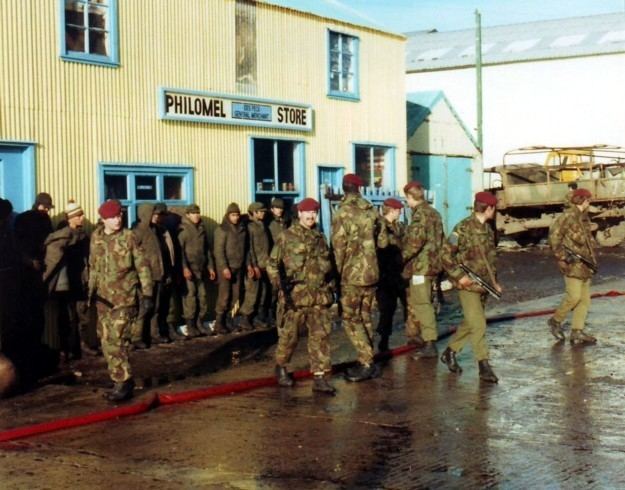 | ||
The last stage of the Falklands War was the surrender of the Argentine Governor at Port Stanley.
Contents
Background
With the last natural defence line at Mount Tumbledown breached, the Argentine town defences of Port Stanley began to falter. In the morning gloom, one company commander got lost and his junior officers became despondent. Private Santiago Carrizo of the 3rd Regiment described how a platoon commander ordered them to take up positions in the houses and "if a Kelper resists, shoot him", but the entire company did nothing of the kind.
At 2100 hours on 14 June 1982, the commander of the Argentine garrison in Stanley, General Mario Menéndez, surrendered to the Major General Jeremy Moore. The surrender was in conflict with the Argentine Army code stating that a surrender was illegal unless more than 50% of the men were casualties and 75% of the ammunition was spent.
The terms of the surrender document were slightly changed after negotiation by General Menéndez. The phrase unconditional surrender was changed for the term surrender. The Argentines were granted:
Surrender document
Present at the signing of the letter of surrender were:
The letter of surrender read:
Confiscated Argentine equipment
Quantities are approximates:
Some of the equipment was rendered useless by Argentine personnel before the surrender.
The Argentine Rattenbach commission (Spanish: Informe Rattenbach) was assembled after the war to investigate the causes of defeat. It recommended serious penalties for some of the officers in charge, but its influence on the later trial was practically nil.
Aftermath
On 20 June, the British retook the South Sandwich Islands and declared hostilities to be over after removing Argentina's Southern Thule garrison at the Corbeta Uruguay base. Corbeta Uruguay was established in 1976, but the Argentine base was only contested through diplomatic channels by the UK until 1982.
The war lasted 74 days, with 255 British and 649 Argentine soldiers, marines, sailors, and airmen, and three civilian Falklanders killed.
The British Government decreed that all classified information would be available to the public in the year 2082. However, following the Freedom of Information Act, a great deal of formerly classified material is now available.
The surrender document is on display at the Imperial War Museum in London. As noted in the museum, the time of surrender was backdated three hours in order that both Zulu time (UTC) and the local time were recorded as 14 June even though technically it was already 15 June in London, in order to prevent possible confusion by Argentine troops who might have mistakenly thought that they were permitted to keep fighting until the next day, 15 June 1982.
Relations between the UK and Argentina were not restored until 1989 and only under the umbrella formula which states that the islands sovereignty dispute will remain aside.
